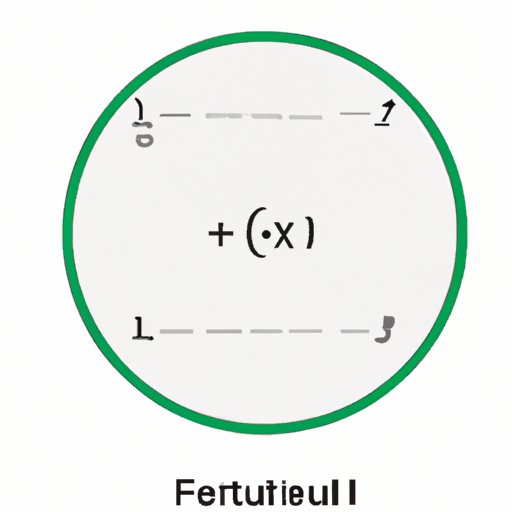Introduction
Circumference is the distance around the edge of a circle. It’s a fundamental concept in geometry and has applications in various fields like construction, engineering, and crafting. In this article, we’ll provide step-by-step instructions to help you find circumference, real-life applications, and even a historical perspective on the formula. By the end of this article, you’ll have a comprehensive understanding of how to find circumference.
Step-by-step guide
The formula for finding the circumference of a circle is C = 2πr or C = πd, where C is the circumference, r is the radius, and d is the diameter. Here’s how to find the circumference using each formula:
Using C = 2πr:
Step 1: Measure the radius of the circle. The radius is the distance from the center of the circle to the edge.
Step 2: Multiply the radius by 2π (approximately 3.14). This will give you the circumference.
For example, if the radius of the circle is 5 cm:
C = 2πr = 2π(5cm) = 31.4 cm
Using C = πd:
Step 1: Measure the diameter of the circle. The diameter is the distance across the circle, passing through the center.
Step 2: Multiply the diameter by π. This will give you the circumference.
For example, if the diameter of the circle is 10 cm:
C = πd = π(10cm) = 31.4 cm
It’s important to note that π (pi) is approximately 3.14, but it’s an irrational number that goes on infinitely without repeating. When calculating circumference, it’s recommended to use an accurate value of π, like 3.14159, or a calculator with a π function.
It’s also important to double-check your units. Make sure that the radius and diameter are measured in the same units, and that the resulting circumference is in the correct units. If not, convert the units as needed.
Real-life applications
Knowing how to find circumference can be useful in many real-life scenarios. For example:
Construction
Architects and engineers use circumference to measure circular structures, like columns and beams. This helps them determine the amount of materials needed and the weight-bearing capacity of the structure.
Crafting
If you’re making a circular tablecloth, rug, or any other item, you’ll need to calculate the circumference to know the length of fabric you’ll need. Similarly, if you’re painting or stenciling a circular design, knowing the circumference will help you plan the size and placement of the design.
Mathematics
Calculating circumference is integral to many advanced mathematical equations, like calculating the area of a circle or finding the surface area of a sphere.
Calculating without a formula
Although using the formula is the most accurate and efficient way to find circumference, there are alternative methods you can use if you don’t have access to a measuring tool or calculator.
Using a ruler:
If you have a ruler or measuring tape, you can measure the distance around a circle by laying the ruler along the edge and marking where it meets. Then, measure the distance between the markings to find the circumference.
Using a string:
Another way to measure the circumference is to tie a string around the edge of the circle, then measure the length of the string. However, this method is less accurate, especially with larger circles, as the string may not lay flat against the edge of the circle.
Interactive calculator
If you prefer a digital method of finding circumference, you can use our interactive calculator! Here’s how to use it:
Step 1: Enter the value of the radius or diameter in the appropriate box.
Step 2: The calculator will automatically calculate and display the circumference.
If you’re interested in the math behind the calculator, it uses the C = 2πr formula to calculate circumference, where r is the value you entered. The calculator rounds the value of π to 3.14 for simplicity.
Historical perspective
Mathematicians have been studying the properties of circles for thousands of years, with the earliest known approximations of π found in ancient Egypt and Babylon. The first accurate calculation of π was done by Ancient Greek mathematician Archimedes in the third century BCE.
The formula for finding circumference is often attributed to the ancient Greek mathematician Euclid, who lived around 300 BCE. However, there is evidence that the formula was known even earlier in ancient Babylonia.
Throughout history, the formula has been used in various fields and industries. For example, in the 1700s, mathematician Daniel Bernoulli used the formula to calculate the airflow around curved objects. In the early 1900s, astronomers used the formula to calculate the size of celestial bodies, like planets and stars.
Conclusion
Finding circumference is a useful skill to have, with applications in construction, crafting, and advanced mathematics. Whether you use the formula, a measuring tool, or a digital calculator, knowing how to find circumference can come in handy in many situations. We hope this comprehensive guide has helped you understand the concept and its real-life applications. For more information on geometry and math, check out our additional resources.
